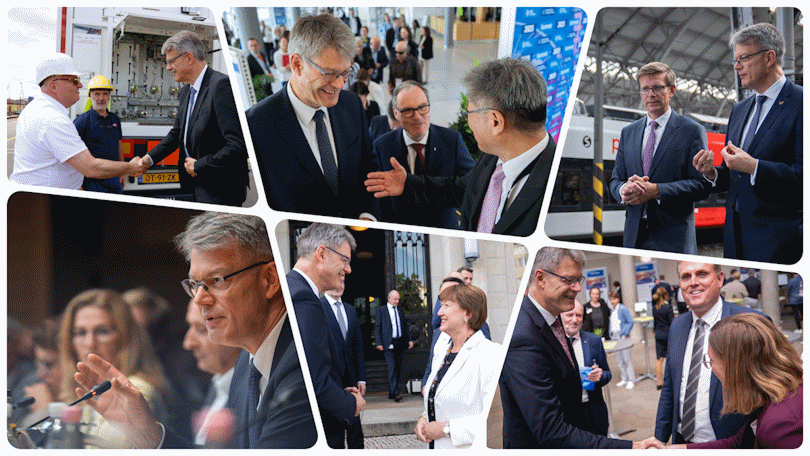
Source: BMV
From dilapidated bridges and roads to unpunctual trains, the challenges to tackle in the first 100 days in office were immense. Unfortunately, our transport infrastructure is not yet as efficient and reliable as it should be. We are setting out to change this by investing and ending the rehabilitation backlog, prioritizing structural maintenance over new construction. Modern transport policy is a marathon, not a sprint. In the first few weeks, we have already been able to tackle and drive forward important projects, especially major investments in our transport infrastructure.
Transport policy is teamwork
In his first 100 days of office, Patrick Schnieder has exchanged ideas and views on modern mobility and transport policy with many experts, stakeholders from civil society and associations as well as international colleagues. In mid-July, for instance, he met with a number of representatives from the automotive and component supply industries to discuss autonomous driving. After all, there is no doubt that this form of mobility offers a great opportunity to counteract the shortage of drivers in logistics and local public transport and to better connect rural regions.
We want to make Germany one of the world’s leading hubs for innovation and production in the autonomous driving sector,
says Patrick Schnieder, Minister of Transport.
We are stronger together than alone – this holds true at international level, too. At the International Transport Forum in May, Patrick Schnieder met with his counterparts from all over the world. The main topic was how to make our infrastructures resilient and fit for the future through close cooperation.

Source: BMV | 
Source: BMV |

Source: BMV | 
Source: BMV |
Investing in our infrastructure
All projects to improve transport infrastructure, combat climate change and enhance reliability need a financial basis. In the 2026 budget, we are therefore focusing on maintaining the capacity of our infrastructure and on investing in rehabilitation, safety and digitalization in a targeted manner.
For the entire parliamentary term until 2029, a total of 166 billion euros from the regular budget as well as the special ‘Infrastructure and climate neutrality’ fund has been earmarked for transport investments. That is 60 percent more than in the previous five-year period from 2020 to 2024. Besides investments in the railways, roads and bridges, the transport budget includes funds for the waterways as well as cycling, walking and aviation. To ensure that the funds can be used quickly where needed, we intend to accelerate planning and approval procedures. Our motto for the first 100 days and the years ahead is: Construction instead of constraints, bulldozers instead of bureaucracy.
Now is the time to plan, build and spend – and do so as quickly as possible. We will all have to get used to even more roadworks in order to restore our transport infrastructure. The primary focus is on upgrading and maintenance, especially when it comes to the rail network and the motorway bridges.
says Patrick Schnieder, Minister of Transport.
Rail upgrades
Our objective is clear: more reliable and efficient rail services and better mobility in Germany. There is an enormous need for action where Deutsche Bahn and its infrastructure are concerned. That is why we are investing more than 100 billion euros in the railways in the period to 2029. Patrick Schnieder wants to continue the success story of the Deutschlandticket and work with the federal states to create a reliable financial basis. A coordination group has been set up for this purpose and tasked to draw up a proposal by autumn.
Progress through digitalization
The digital transformation offers great potential, for instance when it comes to cutting red tape. We are working at full speed to introduce digital vehicle registration documents and make them available in an app. The new parking space information service (SID) will digitalize and simplify the search for truck parking spaces. Data from the toll system shows in virtual real time where there is still space at roadside rest areas. Truck drivers can see parking occupancy directly in their navigation systems and react in good time.
Digital progress is also evident on the railways: In July, a locomotive was retrofitted for automated regular operation for the first time. Equipped for ATO (Automatic Train Operation) and RTO (Remote Train Operation), it will start operating on the Betuwe line between Rotterdam and Germany in autumn. The locomotive starts, stops and brakes on its own. A train driver will remain on board to ensure safety. A team monitors operations remotely and can intervene at any time. This example shows how we can use digitalization to counter the shortage of skilled labour.
Climate-friendly, attractive and affordable mobility
To achieve our climate targets, we are favouring a technology agnostic approach and relying on specialist expertise. This is why Patrick Schnieder set up the Expert Forum for Climate-Friendly Mobility and Infrastructure (EKMI). In just five weeks, 27 independent representatives from the scientific community and practice discussed, analysed and developed cross-modal recommendations.
Our objective is clear: We want to reduce emissions and offer climate-friendly services.
Mobility is a prerequisite for quality of life and prosperity in this country, As such, it has to be affordable and available for everyone, and as environmentally sustainable as possible. That is a mission we take very seriously.
says Patrick Schnieder, Minister of Transport.

Source: BMV | 
Source: BMV |

Source: BMV | 
Source: BMV |